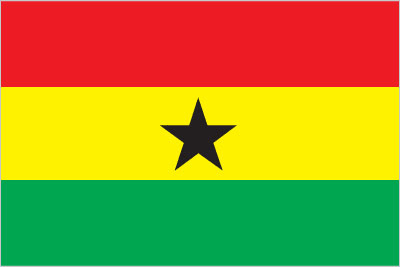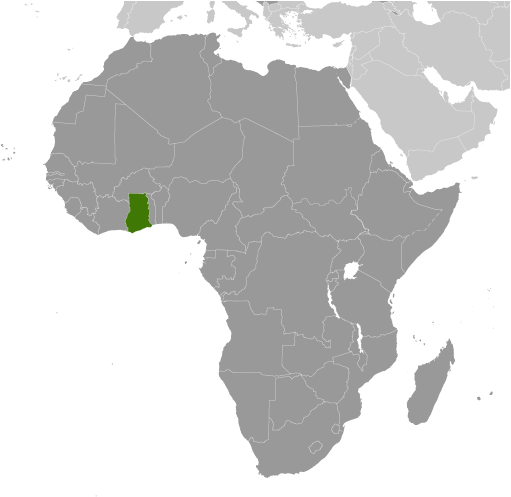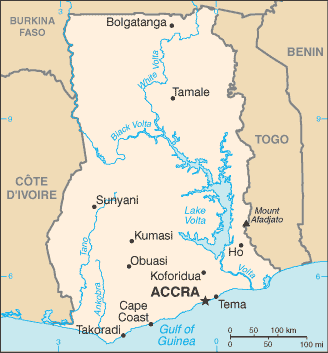|
Economy - overview:
|

|
|
Ghana's economy has been strengthened by a quarter century of relatively sound management, a competitive business environment, and sustained reductions in poverty levels. Ghana is well endowed with natural resources and agriculture accounts for roughly one-quarter of GDP and employs more than half of the workforce, mainly small landholders. The services sector accounts for 50% of GDP. Gold and cocoa production and individual remittances are major sources of foreign exchange. Oil production at Ghana's offshore Jubilee field began in mid-December, 2010, and is expected to boost economic growth. President MAHAMA faces challenges in managing new oil revenue while maintaining fiscal discipline and resisting debt accumulation. Estimated oil reserves have jumped to almost 700 million barrels. Ghana signed a Millennium Challenge Corporation (MCC) Compact in 2006, which aims to assist in transforming Ghana's agricultural sector. Ghana opted for debt relief under the Heavily Indebted Poor Country (HIPC) program in 2002, and is also benefiting from the Multilateral Debt Relief Initiative that took effect in 2006. In 2009 Ghana signed a three-year Poverty Reduction and Growth Facility with the IMF to improve macroeconomic stability, private sector competitiveness, human resource development, and good governance and civic responsibility. Sound macro-economic management along with higher prices for oil, gold and, cocoa helped sustain high GDP growth in 2008-12.
|
|
|
GDP (purchasing power parity):
|

|
|
$83.18 billion (2012 est.)
country comparison to the world: 79
$76.89 billion (2011 est.)
$67.22 billion (2010 est.)
note:
data are in 2012 US dollars
|
|
|
GDP (official exchange rate):
|

|
|
$40.12 billion (2012 est.)
|
|
|
GDP - real growth rate:
|

|
|
8.2% (2012 est.)
country comparison to the world: 15
14.4% (2011 est.)
8% (2010 est.)
|
|
|
GDP - per capita (PPP):
|

|
|
$3,300 (2012 est.)
country comparison to the world: 173
$3,200 (2011 est.)
$2,800 (2010 est.)
note:
data are in 2012 US dollars
|
|
|
GDP - composition by sector:
|

|
|
agriculture: 24.6%
industry:
27.4%
services:
47.9% (2012 est.)
|
|
|
Labor force:
|

|
|
11.67 million (2012 est.)
country comparison to the world: 47
|
|
|
Labor force - by occupation:
|

|
|
agriculture: 56%
industry:
15%
services:
29% (2005 est.)
|
|
|
Unemployment rate:
|

|
|
11% (2000 est.)
country comparison to the world: 117
|
|
|
Population below poverty line:
|

|
|
28.5% (2007 est.)
|
|
|
Household income or consumption by percentage share:
|

|
|
lowest 10%: 2%
highest 10%:
32.8% (2006)
|
|
|
Distribution of family income - Gini index:
|

|
|
39.4 (2005-06)
country comparison to the world: 65
40.7 (1999)
|
|
|
Investment (gross fixed):
|

|
|
25.1% of GDP (2012 est.)
country comparison to the world: 52
|
|
|
Budget:
|

|
|
revenues: $8.375 billion
expenditures:
$10.74 billion (2012 est.)
|
|
|
Taxes and other revenues:
|

|
|
20.9% of GDP (2012 est.)
country comparison to the world: 153
|
|
|
Budget surplus (+) or deficit (-):
|

|
|
-5.9% of GDP (2012 est.)
country comparison to the world: 170
|
|
|
Public debt:
|

|
|
47.4% of GDP (2012 est.)
country comparison to the world: 71
38.2% of GDP (2011 est.)
|
|
|
Inflation rate (consumer prices):
|

|
|
9.1% (2012 est.)
country comparison to the world: 193
8.7% (2011 est.)
|
|
|
Central bank discount rate:
|

|
|
18% (31 December 2009)
country comparison to the world: 8
17% (31 December 2008)
|
|
|
Commercial bank prime lending rate:
|

|
|
25.1% (31 December 2012 est.)
country comparison to the world: 24
18.2% (31 December 2011 est.)
|
|
|
Stock of narrow money:
|

|
|
$6.042 billion (31 December 2012 est.)
country comparison to the world: 91
$5.925 billion (31 December 2011 est.)
|
|
|
Stock of broad money:
|

|
|
$11.56 billion (31 December 2012 est.)
country comparison to the world: 103
$11.79 billion (31 December 2011 est.)
|
|
|
Stock of domestic credit:
|

|
|
$10.18 billion (31 December 2012 est.)
country comparison to the world: 98
$10.6 billion (31 December 2011 est.)
|
|
|
Market value of publicly traded shares:
|

|
|
$3.097 billion (31 December 2011)
country comparison to the world: 91
$3.531 billion (31 December 2010)
$2.508 billion (31 December 2009)
|
|
|
Agriculture - products:
|

|
|
cocoa, rice, cassava (manioc), peanuts, corn, shea nuts, bananas; timber
|
|
|
Industries:
|

|
|
mining, lumbering, light manufacturing, aluminum smelting, food processing, cement, small commercial ship building
|
|
|
Industrial production growth rate:
|

|
|
5% (2010 est.)
country comparison to the world: 60
|
|
|
Current account balance:
|

|
|
-$4.559 billion (2012 est.)
country comparison to the world: 162
-$3.675 billion (2011 est.)
|
|
|
Exports:
|

|
|
$13.58 billion (2012 est.)
country comparison to the world: 82
$12.79 billion (2011 est.)
|
|
|
Exports - commodities:
|

|
|
oil, gold, cocoa, timber, tuna, bauxite, aluminum, manganese ore, diamonds, horticultural products
|
|
|
Exports - partners:
|

|
|
France 19.1%, Netherlands 10.2%, US 8.6%, Italy 8.1%, UK 4.7%, India 4.2% (2011)
|
|
|
Imports:
|

|
|
$17.52 billion (2012 est.)
country comparison to the world: 82
$15.97 billion (2011 est.)
|
|
|
Imports - commodities:
|

|
|
capital equipment, petroleum, foodstuffs
|
|
|
Imports - partners:
|

|
|
China 20.4%, Nigeria 12.4%, US 7.8%, India 5.6%, Netherlands 5.1%, UK 4.2% (2011)
|
|
|
Reserves of foreign exchange and gold:
|

|
|
$5.888 billion (31 December 2012 est.)
country comparison to the world: 85
$5.805 billion (31 December 2011 est.)
|
|
|
Debt - external:
|

|
|
$11.23 billion (31 December 2012 est.)
country comparison to the world: 89
$9.712 billion (31 December 2011 est.)
|
|
|
Stock of direct foreign investment - at home:
|

|
|
$NA
|
|
|
Stock of direct foreign investment - abroad:
|

|
|
$NA
|
|
|
Exchange rates:
|

|
|
cedis (GHC) per US dollar -
1.815 (2012 est.)
1.512 (2011 est.)
1.431 (2010 est.)
1.409 (2009)
1.1 (2008)
|
|
|
Fiscal year:
|

|
|
calendar year
|
|
|
|





 )
)



